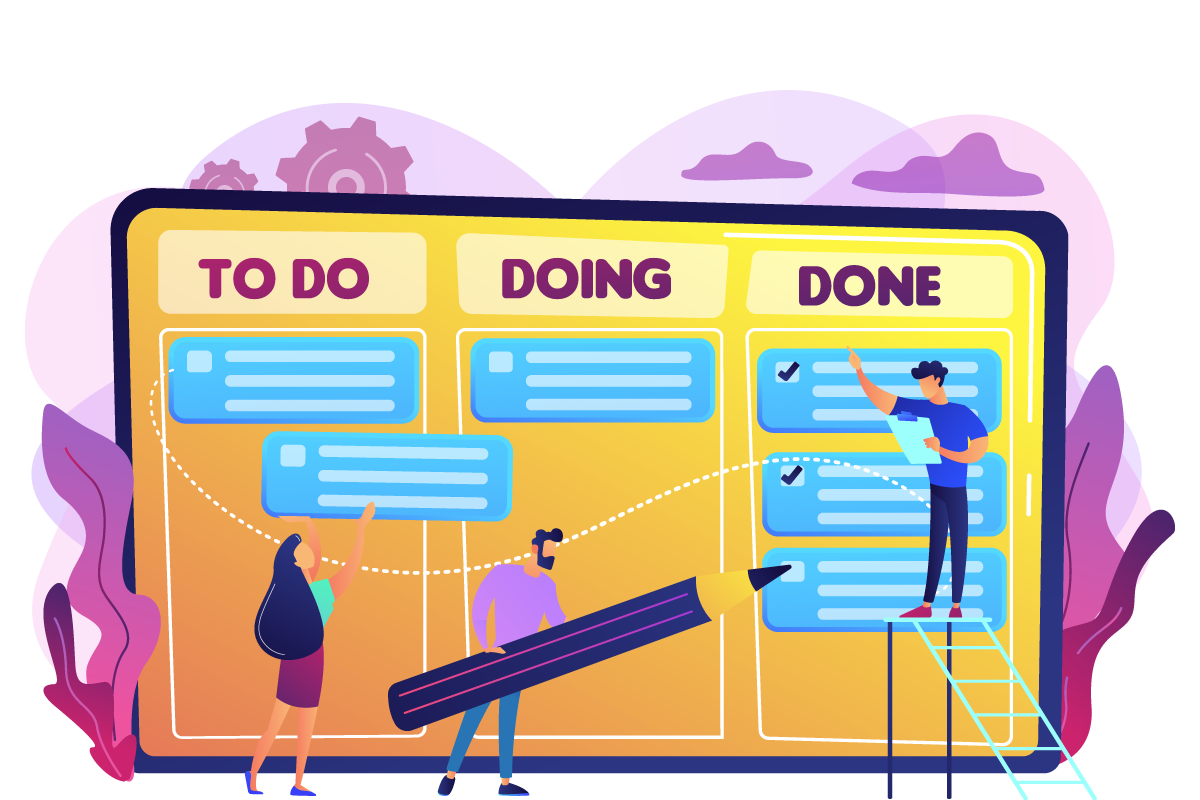How to Balance Managing Yourself While Supporting Your New Remote Teams
These 8 remote work tips will help you manage new remote teams and get your work done without feeling like you're burning the candle at both ends.

Extra communication is the biggest difference between managing remote teams and those working in-house. Unfortunately, it can also lead to distractions and other time-consuming consequences that make handling your own workload more difficult.
So how do you balance managing yourself while supporting your new remote teams? And how do you check-in on projects without micromanaging?
This guide contains a mix of helpful tips to boost your own efficiency and be there for your team, starting with the right game plan:
1. Set a Schedule to Help Maintain Work-Life Boundaries
Remote teams often have flexible work hours. However, it’s essential to structure those work hours so your team knows when you’re on-the-clock and vice versa. This will help you better organize workloads and time off as you start building a remote team.
To manage your schedule:
- Schedule in blocks of time. Chunk your deep and shallow work duties in blocks of 15-minutes to help outline your day around your productivity levels. You may check emails from 10:00 to 10:15, for example, and then deep focus from 10:30 to 11:45. Don’t forget to add a few breaks and a lunch!
- Perform deep work during high productivity times and shallow work when you’re less focused. Don’t let shallow work (like responding to emails) eat up all your mental energy. Schedule your most difficult tasks for when you have the most mental energy during the day.
- Set timers for breaks. Use your phone alarm or an online time tracker to notify you when it’s time to stretch, walk around, disconnect from the screen, and give your brain a minute to relax.

To help support your team’s time management:
- Ask your team for rough “office hours” and strict off-times. These don’t have to be set in stone, but you should have an idea of when everyone prefers working/is most productive. You’ll also want to discourage an “always-on” mindset by asking for out-of-office times.
2. Make Sure Everyone Has a Proper Remote Workspace (Including You!)
Whether you’ve been working remotely for years or just started as a result of COVID-19, a remote workspace is essential for success. Having a separate space for your home life and your office zone also helps create better work-life boundaries.
- Clear the clutter. A messy desk creates a messy mind, and that only makes focusing more difficult. Swap distractions for low-stress indoor houseplants that actually reduce stress and anxiety and boost productivity.
- Find an appropriate desk that’s the right height and depth so you’re not straining your body during work hours. Make sure your arms have support for typing and using your mouse.
- An ergonomic chair with lots of support for your back and neck.
- Headphones or speakers to listen to ambient noise during deep focus work.
When you’re onboarding new work from home employees, make sure they have access to these necessities. Your company may cover the costs of setting up their workspace, send over office equipment, or offer a monthly allowance for the use of coworking spaces. Get this to them within the first week they begin working so they start off on the right foot.
3. Prioritize Physical and Mental Health
Working from home can take a toll on your physical health and mental wellbeing. It’s far too easy to get stuck at your desk for hours without taking a break to get up and move around.
- Always schedule a daily workout. You don’t have to go to the gym to get your heart rate up and your body moving. Consider taking a walk around the neighborhood, doing a yoga video on YouTube, or lifting weights. This time will help you raise energy, productivity, and creativity levels for the rest of the day.
- Don’t be afraid to take breaks. Set your status to away so everyone knows you’re not to be disturbed. The pandemic has put a ton of mental strain on people so it’s okay if you need a little extra time for yourself right now.
- Try a daily 10-minute meditation. There are tons of free apps for guided meditations, but sitting in a quiet place or out in nature works just as well.
To support your team’s health:
- Pay attention to their work hours. Remote employees put in more work hours than their in-house counterparts. So if you see one team member continually burning the midnight oil, make sure to coach them on a healthier work-life balance.
- Set a team step challenge. Set a goal for a daily or monthly amount of steps your team can actually achieve. Have everyone track their steps and work toward a surprise reward if you meet your collective goal.
4. Always Define Roles and Responsibilities
Virtual project management (PM) software like Trello and Asana provides an easy and transparent way for managers to assign tasks and projects to team members.
This software helps you keep track of who’s responsible for what so everyone’s always in the loop. It also prevents tasks from slipping through the cracks or two people working on the same job. And best of all? It allows you to check-in without micromanaging.

To manage projects in your PM software like a pro:
- Include all the details, resources, notes, etc. your team needs to tackle each project. Your team should have everything connected to the project in one organized and central location. Even if this takes extra time on the front-end for you, you’ll notice fewer questions, emails, and back-and-forths later.
- Add deadlines for milestones and deliverables so everyone can see when their work should be done by. Check-in a day or two before these milestones in case issues come up.
- Assign team members and check in with them a day later to make sure they saw the tag. Ensure everyone knows what they’re responsible for and what you’re expecting.
5. Switch to Asynchronous Communication
When managers use synchronous communication, employees must respond to emails and messages immediately. This may leave employees on-edge and take them out of a deep focus (among other downsides).
However, when you switch to asynchronous communication, employees can take their time to reply when it’s best for them. They can schedule blocks of work time and respond to messages during a shallow work window later. This won’t break their concentration and still ensures messages get answered.
Adopting this communication policy means you can stay in touch with your team without interrupting your scheduled work blocks too. Try to check-in at regularly-scheduled times so your employees know when to prepare an update for you, and you won’t have to bother them for it. You’ll also have a better grasp of whether projects are running on schedule.
6. Put an End to Unproductive Meetings
No one has time to waste on unproductive meetings, especially you. After you switch to an asynchronous communication style, you’ll probably only hold meetings for kickoffs, mid-project check-ins, project post-mortems, and times you’ll need to pivot ASAP.
To improve the efficiency of your meetings for you and your team:
- Provide a meeting agenda ahead of time. These talking points will keep you on track and tell everyone what to expect during the call. Then your team can prepare questions and answers beforehand.
- Give everyone an off-camera option. Don’t stress out the introverts on your team. Allow everyone the opportunity to appear on- or off-camera during your meetings, and you’ll find everyone’s more focused on what’s being discussed and eager to participate.
7. Really Get To Know Your Team
Working remotely can feel lonely and isolating at times — especially since many can’t work at the coffee shop, coworking spaces, or libraries thanks to COVID-19. So it’s vital to build in more social interaction between all your team members, including yourself.
- Hold weekly virtual chats for non-work related topics. Everyone can dish about their weekend plans, their latest binge-fest, share funny pet gifs, etc. Schedule additional chats or videos for birthdays, baby showers, holidays, etc.
- Host a watch party where everyone can share the screen, comment on a movie or TV show in real-time together, and bond. You can also hold monthly book club meetings if you’re encouraging less screen time.
- Schedule one-on-one meetings with different team members to discuss their professional and personal development goals.
No one expects you to make it to every meeting or watch party. But it would build camaraderie if you said hello at the beginning, talked to everyone, and then made your exit.
8. Make Time for Gratitude and Recognition
It’s far too easy for remote employees to disappear from your radar. While they’re invisibly working away, they may face periods of isolation and lack appreciation for all the hard work they’re putting in on their own.
One of the best inclusive workplace practices is spreading around well-deserved recognition and praise. So every time they reach a milestone, surpass a goal, exceed your expectations, or simply do a great job, let them know!
You can do this in a flash by sending a quick shout-out in Slack. Tag the all-star employee, briefly explain why they deserve the kudos, and watch your team dole out compliments and happy emojis. Your employee will feel appreciated while others will be encouraged to work hard for kudos like this in the future.
To foster a positive remote work environment, always make time for gratitude and recognition. To do this:
- Set a daily thank-you reminder. Take a minute each day to pause and think about thanking one of your employees for a job well done. You’d be surprised by how far this small act goes towards keeping your team motivated and engaged.
- Set a weekly reminder for praise and recognition. When you’re bogged down in deadlines and deliverables, it can be hard to dole out daily pats on the back. But don’t let a week go by without giving one of your employees kudos.
Supporting Yourself Leads to Higher Performing Remote Teams
Balancing your workload with support for your new remote teams all depends on how well you communicate. When team members are kept in the loop, they’ll have fewer issues and need less help. This leaves more room in your schedule to get your work done efficiently and create time for remote socializing and team-building.